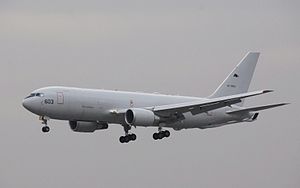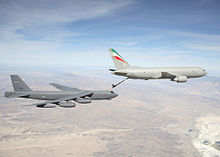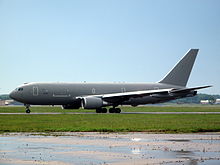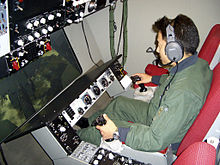Boeing KC-767 Videos
|
Loading...
|
|
Boeing KC-767
KC-767

Picture - Japan Air Self-Defense Force KC-767J
Role/type: Air-to-air tanker
Manufacturer: Boeing
First flight: 21 May 2005
Primary users: Italian Air Force
Japan Air Self-Defense Force
Produced: 2003- present
Number built: 5
Unit cost: ~US$145 million
Developed from: Boeing 767
Variants: Boeing KC-46
The Boeing KC-767 is a military aerial refueling and strategic transport aircraft developed from the Boeing 767-200ER. The tanker received the designation KC-767A in 2002, after being selected by the US Air Force initially to replace older KC-135Es. In December 2003, the contract was frozen and later canceled due to corruption allegations.
The tanker has been developed for the Italian and Japanese air forces, who ordered four tankers each. Financing of the development of the aircraft has largely been borne by Boeing, in that it hoped to get major orders from the U.S. Air Force. Boeing's revised KC-767 proposal to the U.S. Air Force was selected in February 2011 for the KC-X program.
Development
Commercial Derivative Air Refueling Aircraft
The U.S. Air Force (USAF) ran a procurement program to replace around 100 of its oldest KC-135E Stratotankers, part of the "Commercial Derivative Air Refueling Aircraft" program. Most USAF KC-135s are of the updated KC-135R variant.
On 28 March 2002, the Air Force selected Boeing's KC-767 stating they "have clearly demonstrated that only the Boeing Corp. can currently meet the requirements".
The USAF was listed as giving four main reasons for this selection of the KC-767 over Airbus's KC-330 (aircraft's name at the time).
""The KC-330 increase in size does not bring with it a commensurate increase in available air refueling offload,..." (USAF quote)
The KC-330 "..presents a higher-risk technical approach and a less preferred financial arrangement." (USAF quote)
" the size difference of the EADS-proposed KC-330 results in an 81 percent larger ground footprint compared to the KC-135E it would replace, whereas the Boeing 767 is only 29 percent larger." (USAF quote)
The KC-330 requires "..greater infrastructure investment and dramatically limits the aircraft's ability to operate effectively in worldwide deployment." (Summary of Quote by MAT magazine)
In addition, the KC-767 has manual flight controls for an unrestricted flight envelope. The Boeing tanker officially received the KC-767A designation from the DoD in 2002 and appearing in the 2004 edition of DoD Model Designation report.
USAF lease and cancellation
For its Commercial Derivative Air Refueling Aircraft program, the U.S. Air Force decided to lease around 100 KC-767 tankers from Boeing after it was selected. Despite other nations engaging in leasing of military aircraft, there was some criticism. U.S. Senator John McCain questioned whether it is really cost-effective for the USAF to lease aircraft at all, particularly as the aircraft would probably not have many, if any, buyers when their military service was concluded. This was derided as an uninformed criticism, as there were many U.S. allies in need of tanker aircraft. The Congressional Budget Office has also criticized the draft leasing agreement as fiscally irresponsible. In November 2003, a compromise was struck where the Air Force would purchase 80 KC-767 aircraft and lease 20 more.
In December 2003, the Pentagon announced the project was to be frozen while an investigation of allegations of corruption by one if its former procurement staffers, Darleen Druyun (who had moved to Boeing in January) was begun. Reporter Joseph Galloway wrote that some documents found in congressional investigation indicated the A330-based tanker met more of the USAF specifications than the Boeing tanker and had a lower proposed cost. Druyun pleaded guilty and was sentenced to nine months in jail for "negotiating a job with Boeing at the same time she was involved in contracts with the company". Additional fallout included the resignation of Boeing CEO Philip M. Condit and the termination of CFO Michael M. Sears.
In January 2006, Secretary of Defense Donald Rumsfeld announced the cancellation of the Air Force's KC-767A lease. This was designed as a cost cutting measure and as part of a larger reorganization and redefinition of the Air Force's mission which included the retirement of the E-4B fleet, the cancellation of the 767-based E-10 program, as well as the elimination of all but 58 B-52s. Rumsfeld stated that this move will in no way impair the Air Force's ability to deliver the mission of the KC-767A which will be accomplished by continuing upgrades to the KC-135 and KC-10 fleets. Boeing's development of the aircraft for other customers was unaffected by the cancellation however.
International programs

Picture - A KC-767 refueling a USAF B-52H, 2007
Italian Air Force
Boeing continued development of the aircraft. Italy selected the KC-767A and signed a contract in 2002 becoming the launch customer, with delivery set for 2005. The Italian Air Force (Aeronautica Militare) ordered four aircraft. This version is based on the 767-200ER and is named the KC-767 Tanker Transport, and is fitted with boom and hose-drogue refueling systems on the centerline with hose-drogue wingpod systems.
Italy's aircraft became the first KC-767 to be assembled. The aircraft are initially built as 767-200ER commercial airplanes, then flown to a separate facility for conversion into tankers. Italy's first aircraft made its maiden flight on 21 May 2005. Italy's second aircraft arrived for modification at the Naples, Italy facility of Boeing's partner, Aeronavali on 6 May 2005.

Picture - An Italian Air Force KC-767A before delivery at Boeing's Wichita, Kansas facility in 2009
Delivery of the tankers to Italy has been delayed due to an issue with flutter of the wing pods and other technical issues. Boeing provided a 767 for training during this time. After resolving the issues, Boeing delivered the first of four tankers on 27 January 2011.
Japan Self-Defense Forces
In 2001, Japan selected the KC-767 over a tanker version of the Airbus A310 and signed a contract in 2003. The Japan Self-Defense Forces ordered four aircraft and has designated the tanker KC-767J. In June 2005, Japan's first aircraft arrived at Boeing's Wichita, Kansas modification center to be fitted out with the tanker equipment.
Delivery of the first KC-767J for the JASDF was delayed approximately two years due to development issues and the addition of the aircraft receiving FAA certification. The Japanese version of the tanker is equipped only with the boom refueling system. Boeing and its Japanese representative Itochu agreed with Japan Ministry of Defense (MoD) to pay a penalty fee for the delivery delay, according to the MoD Statement. The first operational KC-767A was delivered to Japan on 19 February 2008, with the second KC-767 following on 5 March. The third KC-767 was delivered to the JASDF in March 2009. The three KC-767J aircraft reached initial operational capability (IOC) status with the JASDF in May 2009. The fourth tanker was delivered in January 2010.
Others
Australia selected the Airbus A330 MRTT in April 2004 after competition with the KC-767 due to the A330's larger fuel and cargo capability.
Boeing, teamed with BAE Systems and British Airways, offered the KC-767 to the UK's RAF for its Future Strategic Tanker Aircraft. The companies formed the Tanker Transport Services Consortium (TTSC). British Airways would provide the 767 aircraft. Boeing would provide the conversion technology based on its KC-767 tanker design. BAE Systems would perform the majority of aircraft modifications. Marshall Aerospace, Serco, Spectrum, and Capital were also part of TTSC. The Ministry of Defence announced in January 2004 that it had selected the Airbus A330 MRTT to fulfill this requirement.
USAF KC-X Program
On 24 February 2011, Boeing's KC-767 proposal was selected by the USAF as the winning offer to replace part of the KC-135 fleet. The aircraft will receive the designation KC-46A. Boeing was also awarded a development contract to build, and deliver 18 initial operational KC-46 tankers by 2017.
Operational history
Flight testing

Picture - A Japan Air Self Defense Force boom operator crewman simulates refueling an aircraft at Travis AFB.
On 23 January 2007, the KC-767 flight test aircraft set a program milestone by making its first hookup with a receiver aircraft, a B-52 Stratofortress. The "dry contact" transferred no fuel, but was intended to test the tanker's fifth-generation fly-by-wire telescoping boom. Unlike the KC-135 boom operator, who is prone, the KC-767 operator uses a remote station with a video display. The testing is being done at Edwards Air Force Base, and the test aircraft is destined for Italy once testing is complete.
The KC-767 extended its air refueling boom and transferred fuel to another aircraft for the first time on 5 March 2007. The tanker completed another test milestone on 12 April 2007 when its aircrew successfully extended and retracted both wing refueling hoses. Flight testing has resumed on Japan's tanker after modifications were completed. In November 2007, Boeing decided to shift modification work on the KC-767A tankers for Italy and Japan from subcontractor Aeronavali's facility in Italy to Boeing's Wichita facility in an effort to meet delivery schedules.
Variants
KC-767A
Tanker variant of the 767-200 for the United States Air Force, order cancelled but four similar aircraft built for the Italian Air Force.
KC-767J
Designation for the KC-767A built for the Japan Air Self Defence Force, four built.
KC-46A
Tanker variant of the 767-200LRF for the United States Air Force.
Operators
Italy
Italian Air Force
Japan
Japan Air Self-Defense Force
Specifications (KC-767A)
Specifications for KC-767A Tanker Transport (767-200ER based).
Data from KC-767A, KC-767 Advanced Boeing 767-200ER specifications
General characteristics
Crew: 3: 2 pilots, 1 boom operator
Capacity: up to 200 passengers or 19 463L pallets
Length: 159 ft 2 in (48.5 m)
Wingspan: 156 ft 1 in (47.6 m)
Height: 52 ft (15.8 m)
Empty weight: 181,610 lb (82,377 kg)
Max takeoff weight: 395,000 lb (186,880 kg)
Powerplant: 2 x— GE CF6-80C2 turbofan, 60,200 lbf (268 kN) each
Maximum Fuel Load: 160,660 lb (72,877 kg)
Performance
Maximum speed: Mach 0.86 (570 mph, 915 km/h)
Cruise speed: Mach 0.80 (530 mph, 851 km/h)
Range: 6,385 nmi (12,200 km)
Service ceiling: 40,100 ft (12,200 m)
Related development
Boeing 767
Boeing KC-46
Boeing E-767
E-10 MC2A
Comparable aircraft
Northrop Grumman KC-45
Airbus A310 MRTT
Airbus A330 MRTT
KC-135 Stratotanker
KC-10 Extender
Boeing KC-767 Pictures
More aircraft.
Source: WikiPedia